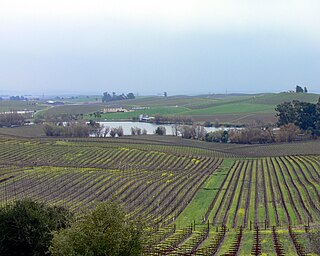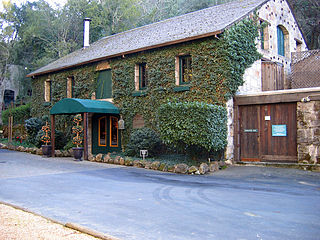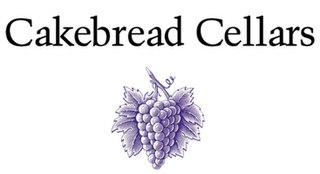
Chardonnay is a green-skinned grape variety used in the production of white wine. The variety originated in the Burgundy wine region of eastern France, but is now grown wherever wine is produced, from England to New Zealand. For new and developing wine regions, growing Chardonnay is seen as a 'rite of passage' and an easy entry into the international wine market.

Pinot noir or Pinot nero is a red-wine grape variety of the species Vitis vinifera. The name may also refer to wines created predominantly from pinot noir grapes. The name is derived from the French words for pine and black. The word pine alludes to the grape variety having tightly clustered, pinecone–shaped bunches of fruit.

Bien Nacido Vineyards is cool-climate vineyard on the central coast of California. Located midway up the Santa Maria Valley, it is known for growing Burgundian and Rhone varieties of wine grapes. Bien Nacido has the distinction of being one of the major viticultural nurseries in the state for certified, varietal budwood. Most of the vines were originally from stock grown by the University of California at Davis. While the average increase block in California is less than 10 acres (40,000 m2), Bien Nacido Vineyards has several hundred acres of certified Chardonnay, Pinot Noir, Merlot and a number of other varieties. Much of the Chardonnay planted in California in the last twenty years began as Bien Nacido Vineyards cuttings.

B.R. Cohn Winery is a winery in Sonoma Valley, California in the United States.

The Mendocino County wine is an appellation that designates wine made from grapes grown mostly in Mendocino County, California. The region is part of the larger North Coast AVA and one of California's largest and most climatically diverse wine growing regions. Mendocino County is one of the northernmost commercial wine grape regions in the state with two distinct climate zones separated by the Mendocino Range. Ten American Viticultural Areas have been designated within Mendocino County. Mendocino is one of the leading wine growing regions for organically produced wine grapes. Nearly 25% of the acreage in Mendocino County is grown organically. In 2004, the residents of the county voted to become the first GMO-free county in the United States in an initiative that was supported by many of the county's largest wineries. The county's widespread focus on organic viticulture has inspired journalists to describe it as "California's organic wine Mecca".

Sonoma County wine is wine made in Sonoma County, California, in the United States.

Los Carneros AVA is an American Viticultural Area which includes parts of both Sonoma and Napa counties in California, U.S.A. It is located north of San Pablo Bay. The proximity to the cool fog and breezes from the bay makes the climate in Los Carneros cooler and more moderate than the wine regions farther north in Napa Valley and Sonoma Valley. The cooler climate has made Los Carneros attractive for the cultivation of cooler climate varietals like Pinot noir and Chardonnay. Many of the grapes grown in Los Carneros are used for sparkling wine production. Receiving its AVA status in 1983, the Carneros area was the first wine region in California to be defined by its climate characteristics rather than political boundaries.

The Russian River Valley AVA is an American Viticultural Area (AVA) in Sonoma County, California. Centered on the Russian River, the Russian River Valley AVA accounts for about one-sixth of the total planted vineyard acreage in Sonoma County. The appellation was granted AVA status in 1983 and enlarged in 2005. The area generally lies between Sebastopol and Santa Rosa in the south, and Forestville and Healdsburg in the north. The Russian River Valley has a characteristically cool climate, heavily affected by fog generated by the valley's proximity to the Pacific Ocean. The area is known for its success with cool climate varietals, notably Pinot noir and Chardonnay.

California wine production has a rich viticulture history since 1680 when Spanish Jesuit missionaries planted Vitis vinifera vines native to the Mediterranean region in their established missions to produce wine for religious services. In the 1770s, Spanish missionaries continued the practice under the direction of the Father Junípero Serra who planted California's first vineyard at Mission San Juan Capistrano.

Buena Vista Winery is a winery located in Sonoma, California, United States. It is the second oldest winery in California after the D'Agostini Winery, which was founded a year prior in 1856. It was founded by Agoston Haraszthy in 1857. The winery is located on its original grounds, just east of Sonoma, California.
Foris Vineyards Winery is an American winery located near Cave Junction, Oregon in the Illinois Valley region of the Rogue Valley AVA of Southern Oregon. As one of Oregon's pioneering grape growers, Ted Gerber planted his first vineyard in 1974. For 15 years, Gerber provided fruit to other winemakers, until 1986 when the winery was founded by Ted and Meri Gerber and the Foris label was launched.

Benovia Winery is a family-owned producer of Pinot noir, Chardonnay, and Zinfandel wines in Santa Rosa, California. Founded in 2005 by Joe Anderson and Mary Dewane, Benovia Winery farms three estate vineyards which total 71.67 acres (290,000 m2) and are located in the Russian River Valley AVA and Sonoma Coast AVA in Sonoma County. To supplement the fruit it harvests each year, Benovia purchases additional grapes from two sites farmed by the Martinelli family. Benovia's winemaker, Mike Sullivan, is also co-owner of the winery. Benovia wines are produced and bottled at the winery's winemaking facilities at the Martaella Estate Vineyard in the Russian River Valley AVA. Annual production is approximately 6,000 cases. Benovia wines are sold direct to customers, as well as distributed to restaurants and other retailers for resale.
Cava is a sparkling wine of denominación de origen (DO) status from Spain. It may be white (blanco) or rosé (rosado). The Macabeo, Parellada and Xarel·lo are the most popular and traditional grape varieties for producing cava. Chardonnay and Malvasia are also permitted. Authorized red grapes are Garnacha tinta, Monastrell, Trepat, and Pinot Noir. Only wines produced in the traditional method may be labelled "cava"; those produced by other processes may only be called "sparkling wines". About 95% of all cava is produced in the Penedès area in Catalonia, Spain, with the village of Sant Sadurní d'Anoia being home to many of the largest Catalan production houses. The two major producers are Codorníu and Freixenet. Cava is also produced in other villages in the provinces of Girona, Lleida, Tarragona, and Barcelona in Catalonia, Zaragoza in Aragon, Badajoz in Extremadura, La Rioja, Araba/Álava in the Basque Country, Navarra and València in the Valencian Community.

Cecil O. De Loach Jr. is a California grape-grower and winemaker in the Russian River Valley AVA who has contributed to the reputation and notoriety of Sonoma County viticulture.

Terra de Promissio is a family owned and operated vineyard that grows Sonoma Coast pinot noir grapes. The vineyard is located in the Sonoma Coast AVA, outside Petaluma, California in Sonoma County.

Sokol Blosser Winery is a vineyard, tasting room and winery facility located northeast of Dayton, Oregon in the Red Hills of Dundee in Yamhill County. It was founded by Bill Blosser and Susan Sokol Blosser in 1971 in what is now known as the Dundee Hills AVA. Sokol Blosser Winery is family owned and operated by second-generation co-presidents, siblings Alex and Alison Sokol Blosser, and is the 6th largest wine producer in Oregon. Sokol Blosser is considered to be “synonymous with sustainability,” and produces Pinot Noir, Pinot Gris, Chardonnay, proprietary blends Evolution White and Evolution Red, a range of other Evolution wines, and small quantities of single block Pinot Noirs, Rosé of Pinot Noir, White Riesling dessert wine, and sparkling wine.

Baldacci Family Vineyards is a family-owned winery located in the Stags Leap District AVA of Napa Valley. Established in 1998, Baldacci Family Vineyards owns over 50 acres of sustainably-farmed vines in three distinct Napa Valley appellations: Stags Leap District, Calistoga, and Los Carneros. The wine portfolio is focused on limited-production, estate-grown wines.

Cakebread Cellars is a Napa Valley winery known for its Chardonnay and Sauvignon Blanc wines, which are internationally distributed. Founded in 1973 by Jack and Dolores Cakebread in Rutherford, California, the winery produces approximately 200,000 cases of wine per year.

Artesa Vineyards & Winery is a winery located in Napa, California in the United States.

Kenwood Vineyards is a winery in Kenwood, California, located on Highway 12 in the Sonoma Valley wine country. It is currently owned by Pernod Ricard Winemakers.


















